Dolphin/Gestió de fitxers
Descobrir el Dolphin
La primera secció proposa una visita guiada de Dolphin. La segona va dels conceptes dels diferents tipus d'adreces d'interès. La tercera debat sobre la gestió d'arxius. Finalment, examinem «les coses més útils». Les imatges són clicables -per veure una vista engrandida-.
Informació general
Dolphin o Konqueror?
Aquesta guia d'aprenentatge descriu Dolphin per a KDE SC 4. Konqueror era el gestor de fitxers estàndard en KDE 2 i 3. També podeu utilitzar Konqueror com el gestor de fitxers per omissió en KDE SC 4. Per fer-ho, a partir de KDE SC 4.2 en endavant, obriu Arranjament del sistema i aneu al mòdul . Podeu seleccionar Konqueror o un rang d'altres aplicacions per al seu ús com al gestor de fitxers per omissió.
- D3lphin és una bifurcació de Dolphin per a KDE 3. Li falten certes característiques de Dolphin al KDE SC 4. També és menys conegut, perquè el gestor de fitxers per omissió de KDE 3 era Konqueror. Aquesta bifurcació no està suportada per la comunitat i ja no és més mantinguda pel seu autor.
Introducció a Dolphin
Dolphin és el gestor de fitxers del KDE Software Compilation.
Us mostraré com utilitzar Dolphin per les tasques corrents de gestió de fitxers, i com personalitzar-lo en funció de les vostres necessitats.
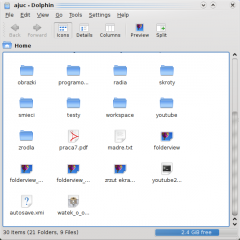
Quan obrim Dolphin des del menú Kickoff aquest mostra el vostre directori inicial, per omissió és el vostre directori inici.
Per obrir un fitxer, o anar a una carpeta només cal fer clic sobre seu. (Això es pot canviar pel doble clic a , Si ho preferiu. Algunes distribucions estableixen el doble clic com per omissió). Al KDE 4.5 això esdevé a .
Per seleccionar i deseleccionar fitxers i carpetes mantenint el cursor del ratolí sobre la icona i fer clic al signe més emergent per seleccionar i al signe menys per deseleccionar. Com segueix:
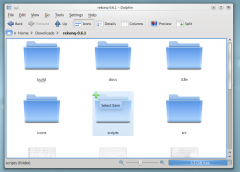
En fer clic al signe més, aquest fitxer o carpeta serà afegida a la vostra selecció. Podeu seleccionar diversos fitxers de la mateixa manera. La selecció també es pot fer arrossegant un rectangle (de vegades anomenat el mètode «rubber band»), i seleccionant i deseleccionant amb Ctrl + clic per a un i Majús. + clic per a un rang consecutiu.
Molts fitxers seleccionats s'assemblarà a això:

Crear una carpeta nova: Podeu crear una nova carpeta al directori actiu utilitzant el o la drecera F10.
Pestanyes: Dolphin suporta la navegació amb pestanyes. Una nova pestanya es pot obrir, per exemple des de , amb la drecera Ctrl + T o fent clic del botó mig del ratolí sobre la icona de carpeta i els botons de navegació.
Dolphin s'obrirà per omissió quan fem clic sobre qualsevol carpeta. També es pot iniciar des del menú Kickoff.
Dolphin integra un nou concepte d'usar la barra de navegació d'una manera més ràpida i precisa: per tant s'utilitza una barra de navegació «fil d'Ariane». En lloc de mostrar la ruta completa, s'anuncien només els punts de navegació en forma de botons. En fer clic en un d'aquests botons, es va directament a aquesta carpeta. D'aquesta manera es pot arribar a una carpeta pare des d'una subcarpeta d'una manera molt ràpida.
Entre els botons que representen una carpeta hi ha una petita fletxa la qual és un botó. En fer clic a la fletxa podreu veure una llista de tots els subdirectoris en el mateix nivell que l'actual, oferint-vos un canvi ràpid de directori.
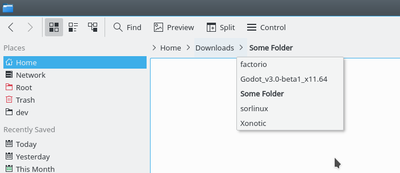
També hi ha una barra de navegació clàssica, que mostra la ruta completa. Per utilitzar aquest estil podeu seleccionar , o activar la drecera de teclat Ctrl + L. En fer clic a l'espai lliure al costat de l'última carpeta que es mostra en l'estil «fil d'Ariane» podreu canviar l'estil clàssic. Si se selecciona l'estil clàssic pareixerà una marca de verificació al final de la barra de navegació. Aquesta marca de verificació és un botó que es pot utilitzar per tornar a l'estil «fil d'Ariane». Per descomptat, el menú i les dreceres de teclat també es poden utilitzar.
Vista dividida
Dolphin ofereix la possibilitat de dividir la vista de la carpeta actual de manera que s'en puguin veure dues una a cada costat com al Midnight Commander. És una vista molt agradable per copiar o moure fitxers des d'una carpeta cap a una altra.
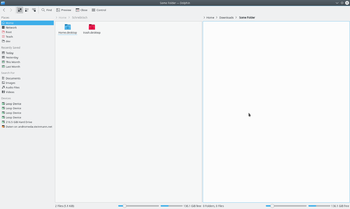
Podeu dividir la vista amb (drecera de teclat F3). Per tornar a una sola vista de carpeta, podeu utilitzar . El símbol mostrarà quina vista serà tancada. En funció de la vista actualment activa es mostrarà el signe menys a la part esquerra o dreta. La vista activa s'haurà tancat. És important saber-ho si desitgeu utilitzar la drecera de teclat. També hi ha un botó per a dividir i tancar la vista situat a la barra d'eines. Aquest també mostra el símbol menys, així doncs és fàcil saber quina vista serà tancada.
Per descomptat, cada vista té la seva pròpia barra de navegació i cada vista pot utilitzar un mode de vista diferent.
Mode de vista
Dolphin permet tres modes de vista diferents : «Icones», «Detalls» i «Columnes». Aquests es poden canviar mitjançant el menú o amb les dreceres de teclat Ctrl+1 (Icones), Ctrl+2 (Detalls) i Ctrl+3 (Columnes). També hi ha un botó per cada mode de vista a la barra d'eines i al menú contextual de la vista de carpeta oferint un submenú per canviar el mode de vista.
Icones
Cada fitxer i carpeta estan representats per una icona en el mode de vista «Icones». En lloc de mostrar una icona de vista prèvia del fitxer que pot mostrar. Aquest comportament es pot activar/desactivar a través del menú o a través d'un botó a la barra d'eines. Hi ha un límit de mida per a les vistes prèvies de fitxers. Aquesta limitació de mida es pot configurar a través de opció . També hi ha una opció per utilitzar miniatures encastades als fitxers. En el KDE 4.5 les vistes prèvies estan habilitades (i la mida màxima definida) amb .
Els fitxers de la carpeta seleccionada per omissió s'ordenen en ordre alfabètic. La manera d'ordenar es pot canviar a través del menú . Els criteris d'ordenació disponibles són els següents:
- Nom
- Mida
- Data
- Permisos
- Propietari
- Grup
- Tipus
- Destí de l'enllaç
- Camí
De manera addicional, l'ordre es pot definir amb .
Hi ha la possibilitat de mostrar informació addicional a sota de les icones. Pot estar activa/desactiva mitjançant . En principi, estan disponibles els mateixos criteris que per a seleccionar la cerca.
Podeu agrupar les icones per aconseguir una millor visió. Aquest comportament s'activa mitjançant . Ara les icones seran agrupades i els grups dividits per una línia horitzontal que contindrà el nom del grup com a títol. L'agrupació està relacionada amb els criteris de cerca seleccionats.
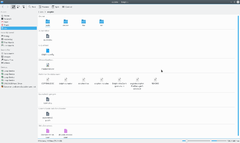
Detalls
In view mode "Details" additional information is displayed by default in contrast to view mode "Icons". All files are listed in a tabular. The context menu of the table header offers the possibility to add additional columns. The following columns are available:
- Mida
- Data
- Permisos
- Propietari
- Grup
- Tipus
- Destí de l'enllaç
- Camí
La columna «Nom» sempre serà mostrada. En fer clic una capçalera d'una de les columnes, la taula serà ordenada segons aquesta columna. En fer clic sobre la capçalera de la mateixa columna l'ordre serà invertit.
Since KDE 4.1 it is possible to display the folders as a tree. In this mode a plus sign is shown next to the folder. By clicking on this sign the folder is expanded and all containing sub folders and files are also shown in the table but they are attenuated. By clicking the sign, which display a minus now, again the expansion is closed again. Of course the tree structure can be used for as many folders as wished. The tree view is disabled by default, but can be activated via with option .
Columnes
View mode "Columns" is inspired by the file manager Finder of Mac OS X. Entering a sub folder does not replace the current folder view but the content of the sub folder is listed in an additional column next to the column of the parent folder. This can be used for several hierarchies, so that you can navigate in an easy and fast way in the file system.
Setting defaults for all folders
Under the menu item you can set any of these attributes to be the default for all folder views.
Plafons
Dolphin contains several panels, which can be activated via menu . Each panel can be placed in the left or right docking area. To move a panel you have to click on the header and Drag&Drop the panel. The area where the panel will be placed on mouse released is highlighted. It is possible to stack panels on top of each other. In this case the panels are placed into tabs.
In the header of each panel there are two buttons. The button near to the caption undocks the panel. This makes the panel an independent window which "floats" above Dolphin. The window is still combined with Dolphin and cannot be displayed without Dolphin and cannot for example be minimized like normal windows. By clicking the button again the panel is docked again. The second button will close the panel.
Diàlegs no modals
When Moving, Copying or Deleting files/directories the dialog disappears even when the operation has not yet completed. A progress bar then appears in the bottom right of the screen, this then disappears also, if you want see the progress you need to click a small (i) information icon in the system tray.
Llocs
Dolphin contains a new kind of bookmarks Places. These are displayed in a panel which can be activated via (keyboard shortcut F9). The default Places are identical to the one shown in the category System of the K-Menu Kickoff.
By clicking one of these places it will be opened in the current folder view. The context menu offers the possibility to edit the places or to remove them again. It is also possible to hide entries temporarily.
The context menu of a folder can be used to add this folder an another entry to the Places panel. Therefore there is a menu item . You can also Drag&Drop a folder to the Places panel.
The places panel also contains entries to connected removable devices like USB-keys or CDs. A small plug icon indicates if the device is mounted. The context menu offers the possibility to unmount the device.
The places are used as the basis in the breadcrumb navigation bar. Each address is shown in relation to the nearest parent folder which is one of the places.
Informació
The information panel can be activated via (keyboard shortcut F11). This panel displays a preview or an icon of the currently selected file/folder or of the file/folder below the mouse cursor. Some additional information like change date or size to the file/folder is displayed as well.
The information panel offers the possibility to rate files, add a comment or tag a file. This is one of the interfaces to the semantic Desktop Nepomuk which provides the advantages of the semantic web for the desktop. Starting from KDE 4.2 it is possible to search for the semantic links given by the tags.
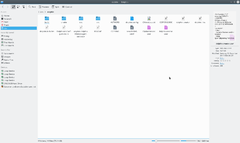
Carpetes
A panel providing a tree structure for the file system can be displayed via (keyboard shortcut F7). The tree structure offers the possibility by clicking the + and - signs to expand/collapse sub folders. By clicking on one of the folders the content will be displayed in the current view.
Terminal
The terminal emulator Konsole can be displayed directly in Dolphin via (keyboard shortcut F4). This makes it possible to use shell commands directly in Dolphin. The terminal is opened in the folder which is displayed in the current view. Shift + F4 opens Konsole in new window.
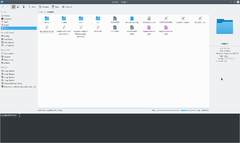
Enllaços externs
Road to KDE 4: Dolphin and Konqueror
Ars Technica: A First Look at Dolphin
Youtube - KDE 4 rev 680445 - Dolphin
Introducing KDE 4 Blog - Dolphin
Bookmarks and Places
In KDE3 you could create bookmarks in Konqueror, but they were not available to any other application. KDE SC 4.x opens up a great deal more flexibility - but that inevitably means more complication. In fact KDE SC 4 has three classes of Bookmarks, which need to be differentiated. They reside in different files, and have different functions.
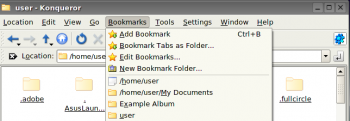
Tres tipus d'adreces d'interès
First, there is the set of bookmarks available only to Konqueror - web bookmarks. These are stored in ~/.kde/share/apps/konqueror/bookmarks.xml. Then there is a set which Dolphin calls Places. This set is available to all applications as well as the Dolphin file manager. Every time you use you will see this set. The third set of bookmarks are Application Bookmarks. These share one file, regardless of the application that set them, and are available to all applications, unless you restrain them to a specific application. More of that later.
Habilitar les adreces d'interès
In most distros Bookmarks are not enabled by default. In order to use bookmarks we first have to enable them. Open a in most KDE applications and you will see, at the right-hand edge of the icon panel, a spanner or wrench. From the drop-down list, choose .
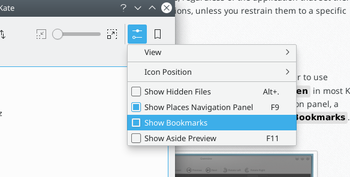
There is a default set of Places -
- Home
- Network
- Root
- Trash
but you can add other places. In Dolphin, right-click on a folder and select , or just drag a folder onto Places.
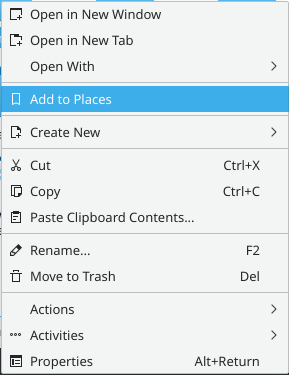
By default this "Place" will be visible in all applications. If you want to keep it constrained to Dolphin, you need to right-click on the new name in the Places list, where you will find the option to Edit it. There is a check-box for .
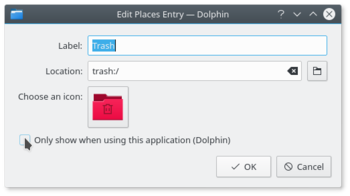
You can see the result of that command if you read ~/.kde4/share/apps/kfileplaces/bookmarks.xml.
In some applications too there is an option in the File menu to add a folder to Places. At this stage, however, applications vary in which features are available. The important thing to remember is that the default is for Places items to be available to all applications in the dialogue.
Adreces d'interès a les aplicacions
This is the second class of bookmarks. Remember opening and using the spanner/wrench? Next to it is a yellow star. This is the bookmark management menu.
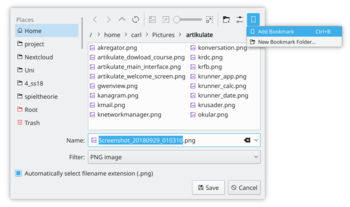
Here you can define bookmarks that will be visible in the same menu on any application. They are stored in one file, ~/.kde4/share/apps/kfile/bookmarks.xml, which is used by all applications having that menu.
Constraining to one application
Some applications allow you to edit items in the Places menu. For instance, if in Gwenview you right click on a folder in Places you can set an option to .
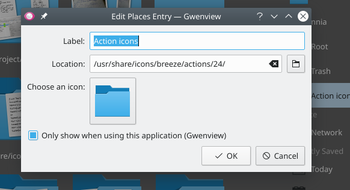
If you need to constrain to an application that does not yet allow you to do that, the only way left is to edit the file ~/.kde/share/apps/kfile/bookmarks.xml. Immediately before the </metadata> tag you will need to add the line
<OnlyInApp>appname</OnlyInApp>
Gestió de fitxers en Dolphin
Managing archives now becomes simple. In any directory in Dolphin, highlight the files that you want to compress, and right-click. Here, using the Compress option, you can elect to create a RAR archive, a Gzipped tar archive, or define another compression mode that you have already set up.
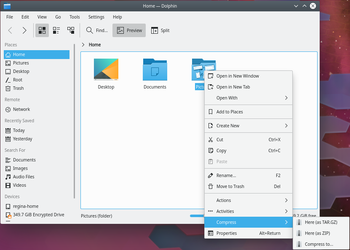
Similarly, if you right-click on an existing archived file you get a range of actions added to the right-click menu. You can extract the archive to the current folder, to an autodetected subfolder or to another place of your choosing.
Should you wish to add files to an existing archive, you can choose .
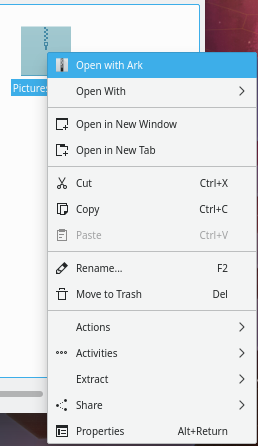
Les accions més útils
Change a File Association on-the-fly
Have you ever wanted to open a file, only to find that it is associated with an application that is not of your choice? You can, of course, alter this in . But Dolphin and Konqueror offer you a quick and cool method for changing a single association.
Right-click on the file and select . The first line there is descriptive, something like:
Type: XML document
At the same level, on the right, there is a spanner (wrench). Click on that and you can add or change an association.
Similarly, by working on a folder, you can change the default file manager to/from Konqueror, if you choose, or add another image browser to the possible associations.
El submenú Accions
The sub-menu opens up a whole lot more cool things to do from Dolphin. Some possibilities only appear when applicable to the file you have selected. Some of the options are
- Convert an image file to a different format
- Preview the file
- Download a remote file with KGet
- Sign and/or encrypt the file, according to the encryption software installed
Codificar i copiar pistes d'àudio CD
- Insert an audio CD
- Navigate to this CD in Dolphin: it must appear as "Volume" in your Dolphin 'Places' or you can reach it by typing audiocd:/ in the address bar.
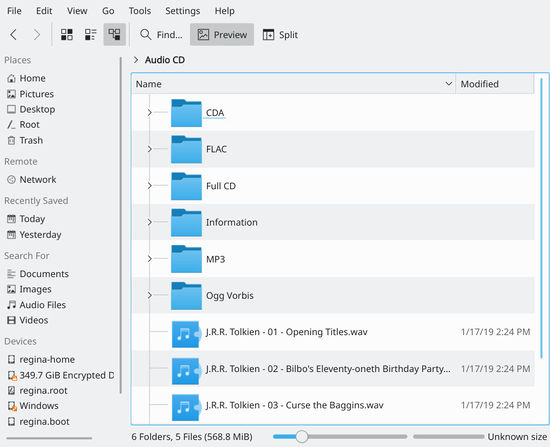
You now notice that Dolphin is proposing a WAV file for each track, plus:
- a CDA folder containing indexing information in the usual CDA format.
- a Whole CD folder, containing one file for each format (.cda, .flac, .mp3, .ogg, .wav) holding all the tracks
- a FLAC folder, containing the tracks encoded into FLAC format (lossless information format)
- an Information folder containing the CDDB informations
- an MP3 folder, containing all the tracks in MP3 format
- a Ogg Vorbis folder, containing the tracks encoded in OGG format
You then just have to copy the folder of your choice, in your preferred format to obtain the relative encoded version of your CD!



